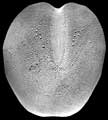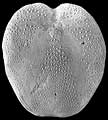The Echinoid Directory
Washitaster Lambert, 1927, p. 271
| Diagnostic Features |
|
|---|---|
| Distribution | Albian, USA. Mexico. |
| Name gender | masculine |
| Type | Hemiaster riovistae Adkins, 1920, p. 115, by original designation |
| Species Included |
|
| Classification and/or Status |
|
| Remarks |
|




